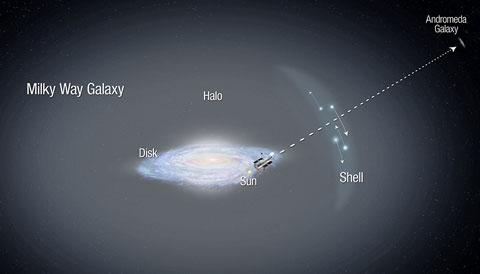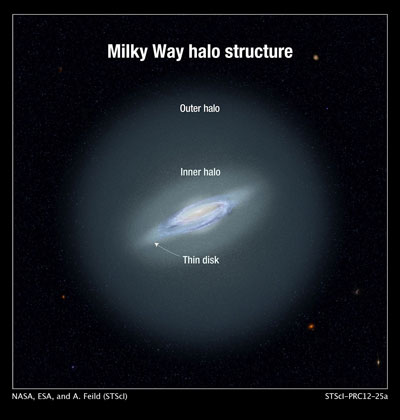The motions of thirteen stars in our galaxy’s halo outline a shell-like structure, perhaps the remains of an ancient galactic collision.

NASA / ESA / A. Feild
Thirteen lonely stars in the outer reaches of the Milky Way may hold clues to our galaxy’s formation. New research shows that they might be part of a shell-shaped relic that marks an ancient run-in with a dwarf galaxy.
In the galactic disk, gas and stars circle the center in orderly orbits, but the same can’t be said of the cloud of stars that surround the Milky Way. Theorists think most of these so-called halo stars were born in a multitude of dwarf galaxies that were later devoured by our own. Now these stars follow orbits that take them in and out of our galaxy’s center rather than around it. At such great distances, these stars move in slow motion, just as Pluto moves far more slowly in its orbit than flighty Mercury, so their orbits “remember” their ancient origins.
Digging Up Relics in Milky Way's Halo

NASA / ESA / J. Dalcanton / B.F. Williams / L.C. Johnson / PHAT / R. Gendler
Three years ago, Alis Deason (then at University of California, Santa Cruz) led a team in measuring the motions of halo stars across the sky. The team took advantage of a Hubble Space Telescope program that was observing the Andromeda Galaxy. Picking out a baker’s dozen of foreground stars that lie in front of Andromeda, Deason and colleagues watched their sideways motion over a period of five to seven years.
Though exact measures of distance aren’t available, these stars are about 65,000 light-years from the center of the Milky Way: square in our galaxy’s halo, which extends out some 300,000 light-years.
“Watching the motion of stars across the face of galaxies is analogous to watching human hair grow on the surface of the Moon as seen from Earth,” says Puragra Guha Thakurta (University of California, Santa Cruz). Yet, he notes, it’s doable.
But the measurements from Deason’s team only gave stellar motions in two dimensions. This year, Emily Cunningham (University of California, Santa Cruz) took on the mantle, leading an effort to collect each star’s spectrum, looking for the shift in spectral lines that would reveal their motions along our line of sight.
Cunningham’s team confirms that these 13 stars defy expectations: they’re not traveling along paths that take them straight into or out of our galaxy. Most likely, they’re part of a shell of stars that are piling up as they turn around in their in-and-out orbits.
“If we are correct in our interpretation of a shell, this shell would be a relic from a past accretion event,” says Cunningham. This shell would be all that’s left of a dwarf galaxy, or perhaps even a group of dwarfs, that fell into the Milky Way’s gravitational grasp several billion years ago.
The alternative is that the stars are actually forming out there, in the farthest corners of the Milky Way. But as James Bullock says, “It’s hard to imagine stars forming out there in regions of such low density.” Moreover, he adds, “cosmological models predict that shells like this should be out there.”
The Future of Galactic Archaeology

NASA / ESA / A. Feild
Ultimately, though, 13 stars is a pretty small sample with which to dig up our galaxy’s history. That’s why Cunningham, Deason, and colleagues are planning a much larger sample in a project known as HALO7D, which will contain information on hundreds of halo stars once observations are complete.
Bullock, whose simulations have outlined our galaxy’s formation history, is excited to see the results of this and other studies. “We aim to figure out what kinds of smaller galaxies fell into the Milk Way (How big were they? What kind of stars were they made of?), and also when those galaxies fell in.”
But even the grandest cosmic implications can’t prevent more prosaic considerations. “We are completely at the mercy of the weather,” says Cunningham. Cloudy nights disrupted plans to finish collecting data last spring, so observing will continue this spring and next, with final results one to two years from now.
References:
E. Cunningham et al. "Isotropic at the Break? 3D Kinematics of Milky Way Halo Stars in the Foreground of M31." Astrophysical Journal, 10 March 2016. Full text.
A. Deason et al. "The Velocity Anisotropy of Distant Milky Way Halo Stars from Hubble Space Telescope Proper Motions." Astrophysical Journal, 4 March 2013. Full text.
 2
2
Comments
Bob
March 11, 2016 at 6:18 pm
Very interesting article. Thank you for researching and writing this article.
...Bob
You must be logged in to post a comment.
Edward Dubois
March 12, 2016 at 10:18 am
A comment on the accretion theory for a belt or cloud of stars within the confines of the our Milky Way Galaxy that seem to act like comets do to our sun.
Because we have the Oort Cloud and Kuiper Belt around our Solar System which periodically send objects toward the Sun, a few thoughts come about. The first would be that if the Oort Cloud is thought to have originated from remnants of the formation of the Solar System, why then approach these new found star motions with a theoretical galactical source other than the Milky Way. The converse to that would be, perhaps the Oort Cloud and Kuiper Belt were from a source outside of our Solar System.
We have no idea of the actual mass of either the Oort or Kuiper of system of objects, just as with the theoretical cloud or belt around the Milky Way other than to speculate that a significant fraction of the mass of our Solar System may be out there and so why would not the same be true of the Milky Way. Dark matter indeed, dark because we have yet to locate it.
You must be logged in to post a comment.
You must be logged in to post a comment.